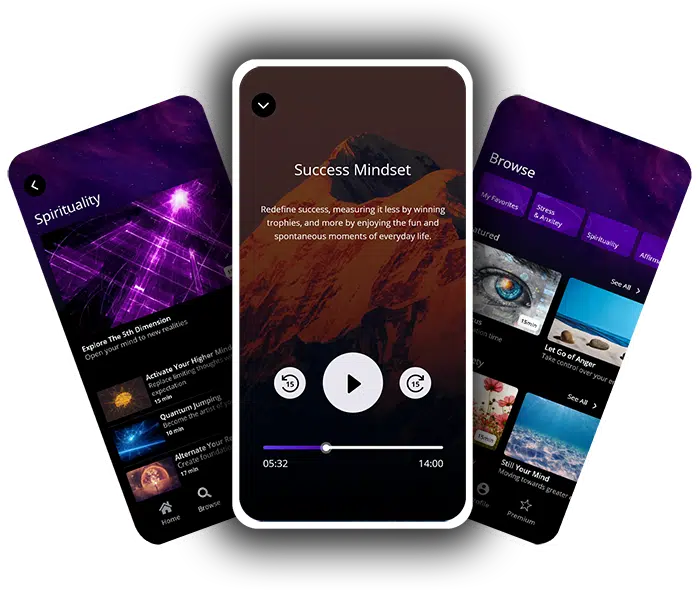Feeling stressed or anxious lately? You’re not alone. Studies show that mindful breathing exercises can significantly reduce stress. This article post will guide you through basics, benefits, and techniques of mastering mindful breathing.
Get ready to breathe the big sigh of relief!

Unleash Your True Potential!
Explore the world of meditation with our powerful guided sessions crafted to bring peace and strength to your spirit.
But first, let’s ensure our sessions are the perfect fit for you.
Take our short quiz to find out!
Table of contents
Understanding Mindful Breathing
Now that we’ve introduced the concept, let’s dive deeper into mindful breathing. It’s a powerful tool you can use wherever you are, requiring nothing more than your breath. Mindful breathing is about paying attention to every inhale and exhale.
You notice the air moving in and out of your body, without trying to change it or judge it. This simple act can turn off stress responses, bring calm and improve focus.
This practice roots in ancient traditions but is backed by modern science for stress reduction and relaxation. When you breathe mindfully, you activate the parasympathetic nervous system—your body’s rest-and-digest mode—which counters the fight-or-flight response triggered by stressors.
It also helps regulate heart rate, reduce negative emotions, and foster self-awareness. Whether sitting quietly at home or amid a stressful situation outside, mindful breathing serves as an anchor to the present moment, helping ground your thoughts away from distractions or worries.
Benefits of Mindful Breathing
Mindful breathing offers pain relief and eases anxiety, reducing negative thinking. It can also provide natural way to manage stress, enahncing emotional well-being and overall mental health. Let’s look at all the benefits in more detail.
Providing Pain Relief
Mindful breathing stands out as a powerful tool for easing pain. Research has also shown that mindfulness meditation can significantly reduce pain in both clinical and experimental settings.
This technique taps into the body’s natural ability to relax, shifting from the fight or flight response to rest and digest mode. By focusing on breath awareness, individuals dealing with chronic pain find relief.
This process involves belly breathing or diaphragmatic breathing, helping manage stress and anxiety which are often linked with heightened pain sensations.
Exercises like deep breathing encourage the mind to stay present, calming both emotional turmoil and physical discomforts such as lower back pain or headaches caused by tension. Many caregivers and healthcare professionals recommend meditative mindful breathing as part of a comprehensive approach to pain management.
It not only helps in reducing reliance on opioids but also enhances emotional health by fostering new neural pathways dedicated to coping with discomfort more effectively.
Reduction of Anxiety
Practicing mindful breathing can truly change how your mind handles anxiety. Studies have proven that mindfulness-based treatments, including focused breathing techniques, significantly reduce symptoms of anxiety.
It’s not just a calming exercise; it’s a powerful tool for emotional regulation. By guiding your concentration to your breaths, you’re training your brain to stay present and calm, even in stressful situations.
You might be surprised to learn that both cognitive-behavioral therapy (CBT) and mindfulness-based stress reduction methods have shown promise in helping people with autism manage their anxiety better.
This shows the universal appeal and effectiveness of these practices across different conditions like insomnia and PTSD symptoms. Taking deep, controlled breaths helps signal your body to relax, shifting away from the fight-or-flight response triggered by anxiety to a more peaceful state of being.
Decrease in Negative Thinking
Regular mindful breathing can reduce negative thinking. It has been proven to decrease negative thinking and provide pain relief. Engaging in mindfulness-based treatments, including mindful breathing, can help improve overall well-being by reducing negative thoughts.
Mindful breathing is beneficial for spiritual growth and personal development. It helps in decreasing negative thinking and improving mental wellness. Mindfulness-based practices have shown significant impacts on reducing negative thoughts and enhancing emotional well-being.
Techniques for Mindful Breathing
Master the art of mindful breathing with techniques like counting breaths, deep breathing, 2-4 breathing, and energizing breaths..Discover how these techniques can enhance your well-being and mindfulness practice.
Counting Breaths
Start by finding a peaceful and quiet spot to sit or lie down comfortably.
As you begin, close your eyes and take a few deep, calming breaths to settle into the present moment before starting with the counting technique.
- Counting breaths is a simple yet powerful technique in mindful breathing that involves counting your breaths to help maintain focus.
- Start by taking slow, deep breath in through your nose while silently counting “one”.
- Then exhale slowly through your mouth, again silently counting “two”.
- Continue this pattern up to ten and then start again from one.
- If your mind wanders, gently guide your attention back to the count without any judgment.
- This practice can help enhance concentration skills, reduce anxiety, and promote a deep sense of calmness throughout the day.
Remember, each time you return to the count, it’s an opportunity to refocus and cultivate mindfulness in your daily life.
Deep Breathing
Deep breathing can also help lower stress and anxiety by calming the nervous system.
You can practice deep breathing techniques to experience its benefits.
- Counting Breaths: Inhale deeply, then slowly exhale while counting each breath to promote relaxation and mindfulness.
- Deep Breathing: Take slow, deep breaths to increase oxygen flow, reduce tension, and lower stress levels.
- 2-4 Breathing: Inhale for a count of 2, hold your breath for 4 counts, then exhale for a count of 4 to regulate your breathing rhythm.
- Energizing Breaths: Perform quick inhales and exhales to energize the body and clear the mind.
Remember that mastering mindful breathing is as simple as focusing on your next breath.
2-4 Breathing
2-4 Breathing is a technique associated with mindful breathing.
- This practice involves inhaling for a count of 2 and exhaling for count of 4, promoting relaxation and reducing stress.
- It can be integrated into your daily routine, whether you are at work, commuting, or relaxing at home.
- The simplicity of 2 – 4 Breathing makes it accessible to beginners and experienced practitioners alike.
- By consciously controlling your breath in this pattern, you can anchor yourself in the present moment and cultivate a sense of calm.
- Research has shown that practicing 2-4 Breathing can positively impact heart rate variability and promote overall well-being.
Try integrating 2-4 Breathing into your daily routine to experience its calming effects during various activities.
Energizing Breaths
After mastering the calming techniques of 2-4 Breathing, you can now explore energizing breaths to invigorate your mind and body. Incorporate these techniques into your mindfulness practice for a refreshing experience. Let’s dive into the different methods:
- Stimulating Breath: Also known as the “Bellows Breath,” this technique involves quick, rhythmic inhalations and exhalations through the nose, creating a natural energy boost.
- Kapalabhati Pranayama: This traditional yoga technique focuses on forceful exhalations through the nostrils, followed by passive inhalation. It clears the mind and revitalizes the body.
- Sitali Pranayama: By curling the sides of your tongue to form a tube shape, you can inhale cool air through your mouth. This breath cools down stress and fatigue, leaving you feeling rejuvenated.
4 Wind-Relieving Breath: While lying on your back with knees pulled toward your chest, take slow deep breaths to relieve tension in the abdomen and promote a sense of lightness and vitality.
5 Power Breathing: Stand tall and take strong inhales through your nose while raising arms overhead, then exhale forcefully through pursed lips while lowering arms. This full-body breath ignites vigor within.
Embrace these energizing breath techniques to elevate your mindfulness practice and infuse vitality into every aspect of your life.
Remember to integrate these techniques gradually into your practice to ensure comfortable adaptation.
Mindful Breathing Exercises and Activities
Explore a Mindful Breathing Training Exercise to enhance focus and relaxation. Try Beginner’s Breathing Meditation for a simple introduction to the practice.

Unleash Your True Potential!
Explore the world of meditation with our powerful guided sessions crafted to bring peace and strength to your spirit.
But first, let’s ensure our sessions are the perfect fit for you.
Take our short quiz to find out!
A Mindful Breathing Training Exercise
Get comfortable in a quiet space and sit or lie down. You can also close your eyes and take few deep breaths to relax.
- Start by bringing your attention to your breath – observe the natural rhythm without trying to change it.
- Slowly deepen your breath, taking long, deep inhales through your nose and exhaling entirely through your mouth. Focus on this sensation of breath entering and leaving your body.
- Gradually shift your attention to different parts of your body, noticing any tension or sensations as you continue breathing deeply.
- If your mind wanders, gently bring it back to the present moment, focusing on the flow of breath and bodily sensations.
- Practice this exercise for 5 – 10 minutes daily, gradually increasing duration as you start feeling more comfortable with it.
- Take note of how you feel after each session – increased calmness, reduced stress, or improved focus indicate that mindful breathing is benefiting you.
Remember that consistency is key; make mindful breathing a regular part of your routine for maximum benefits.
Beginner’s Breathing Meditation
To start, find a quiet space to sit or lie down comfortably.
Close your eyes and take a few natural breaths, allowing your body to settle into a relaxed state.
- Begin by taking deep breaths in through nose, filling your lungs and expanding the belly.
- Now exhale slowly through the mouth, releasing any tension or stress with each breath.
- Focus on sensations of the air entering and leaving your body, bringing your attention back to the present moment if it drifts away.
- As you breathe, notice any thoughts or emotions that arise without judgment, simply observing them as they pass by.
- Maintain this practice for 10 – 15 minutes daily, gradually increasing duration as you start feeling more comfortable with the process.
Remember to embrace any distractions that may come up during this meditation without attaching any significance to them!
Triangle Breathing
Triangle breathing is a powerful mindful breathing exercise that promotes relaxation and lowers stress and anxiety.
- Visualize…a triangle with three points while inhaling deeply through your nose, imagining the breath tracing the first side of the triangle.
- Hold…your breath for the same length of time as your inhalation, picturing the breath moving along the second side of the triangle.
- Exhale…slowly and completely for the duration matching your inhalation, envisioning the breath traveling along the third side of the triangle.
When practiced regularly, this technique helps manage stress, anxiety, promoting overall well-being and mental clarity.
Anchor Breathing
Now that you’ve learned about Triangle Breathing, let’s explore another powerful mindful breathing technique – Anchor Breathing. This practice involves focusing all your attention on sensation of your breath as it’s entering and leaving your body. Here are some ways to incorporate Anchor Breathing into your mindfulness routine:
- Begin by finding comfortable position, whether sitting or lying down, where you can easily focus on your breath.
- Inhale deeply through nose, feeling the air fill your lungs, and then exhale slowly and steadily.
- As you breathe, imagine each inhale and exhale as an anchor grounding you to present moment.
- If your mind starts to wander, try to gently bring your attention back to the rhythm of your breath, using it as a focal point for mindfulness.
- Practice Anchor Breathing for a few minutes each day to cultivate a greater sense of presence and calm in your daily life.
Remember that Anchor Breathing is a simple yet profound technique that can help you anchor yourself in the present moment and foster a deeper connection with yourself and the world around you.
Conclusion
Master the art of mindful breathing to unlock its numerous benefits. Enhance pain relief, reduce anxiety, and banish negative thinking. Practice various techniques – counting breaths, deep breathing, 2-4 breathing.
Engage in mindfulness exercises like triangle breathing and anchor breathing. Elevate your well-being through these simple yet powerful practices.
FAQs
What is mindful breathing, and how can it help me?
Mindful breathing is a meditation technique where you focus on your breath to stay present. It helps reduce stress, improves memory, and even supports heart health. Think of it as giving your mind a break from all the noise.
Can mindful breathing exercises really change my brain?
Yes! Studies show that practices like mindfulness-based stress reduction (MBSR) can grow parts of your brain like the hippocampus, which deals with emotions and learning. Plus, they calm the amygdala, making you less reactive to stress.
I’m always distracted; will these techniques work for me?
Absolutely! Mindful breathing teaches you to bring your attention back whenever you get distracted. It’s perfect for people who feel their minds are always elsewhere.
How long does it take to see benefits from practicing mindfulness of breathing?
Some folks feel calmer after just one session! But lasting changes in how you handle stress or anger might take a few weeks of regular practice.
Is this something only adults can do? What about kids or teens?
Everyone can benefit from mindful breathing—kids, teens, even older adults dealing with arthritis or cancer survivors find relief through these techniques.
Are there specific exercises I should start with if I’m new to this?
Starting with guided meditations focused on the breath is great for beginners. You could also try simple mindfulness breathing exercises like counting breaths or doing a body scan to become more aware of each part of your body.










